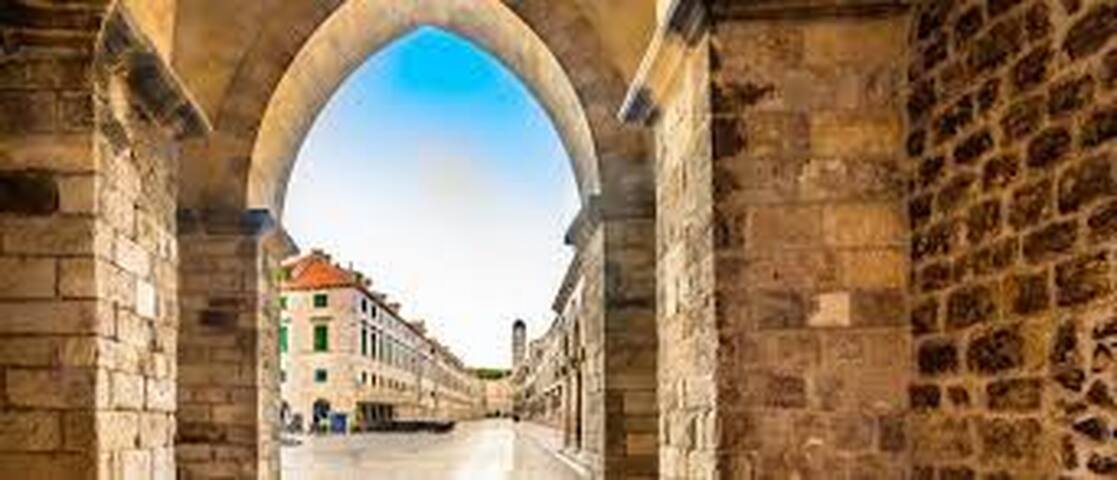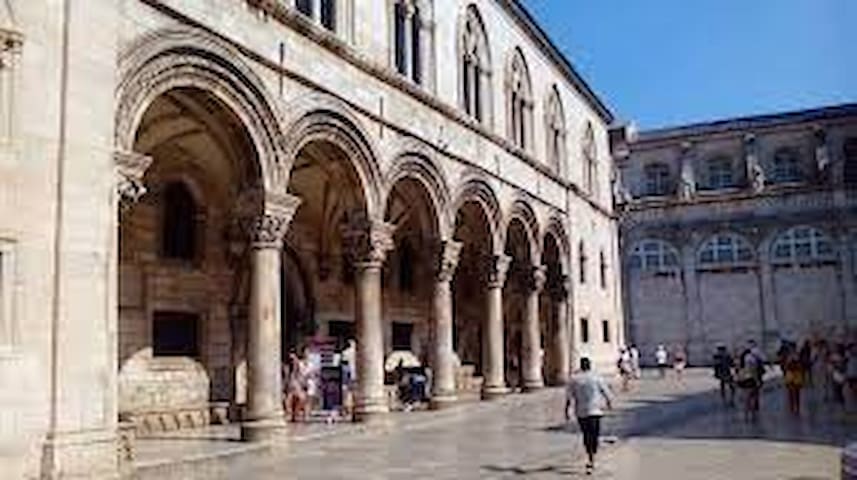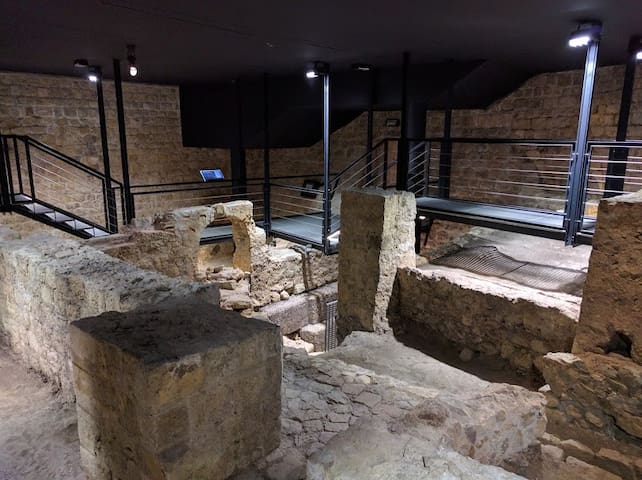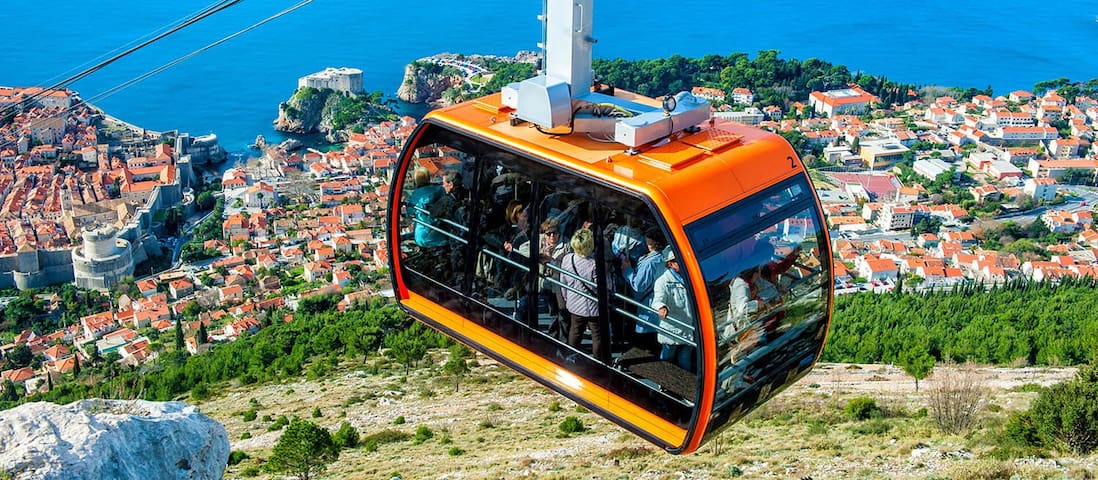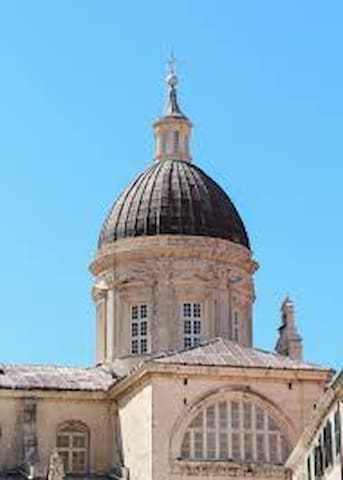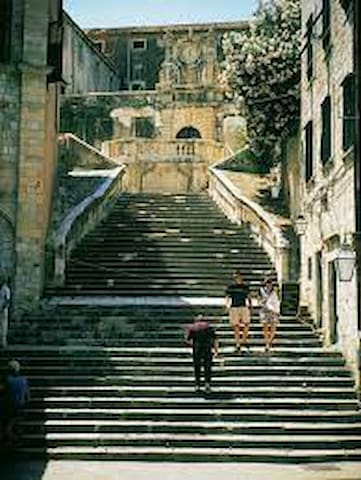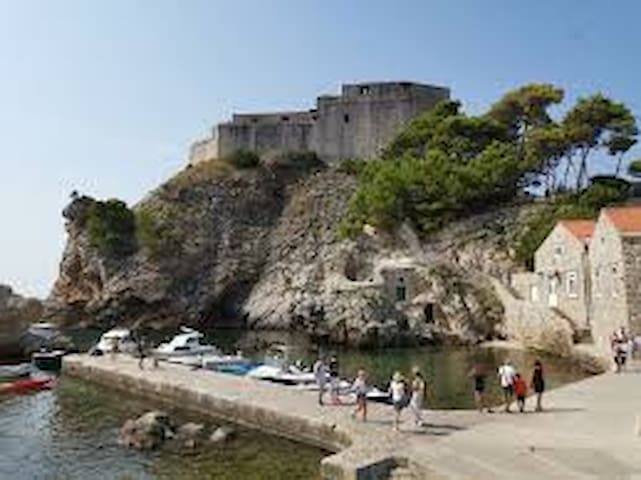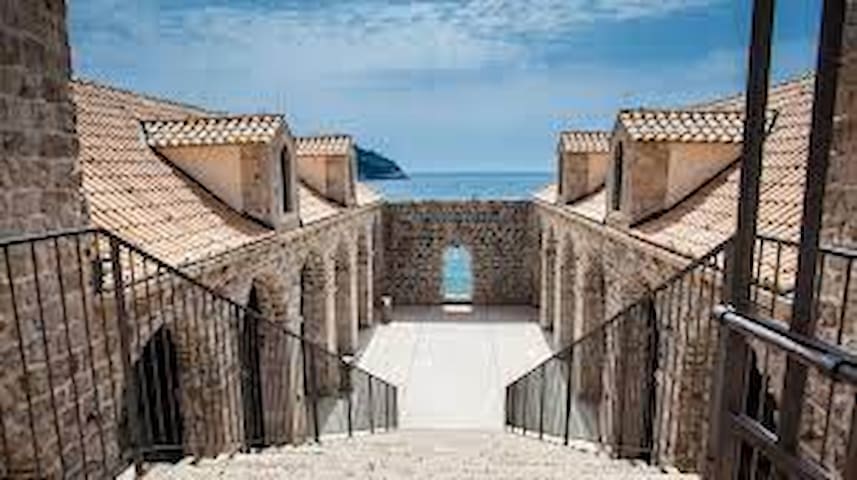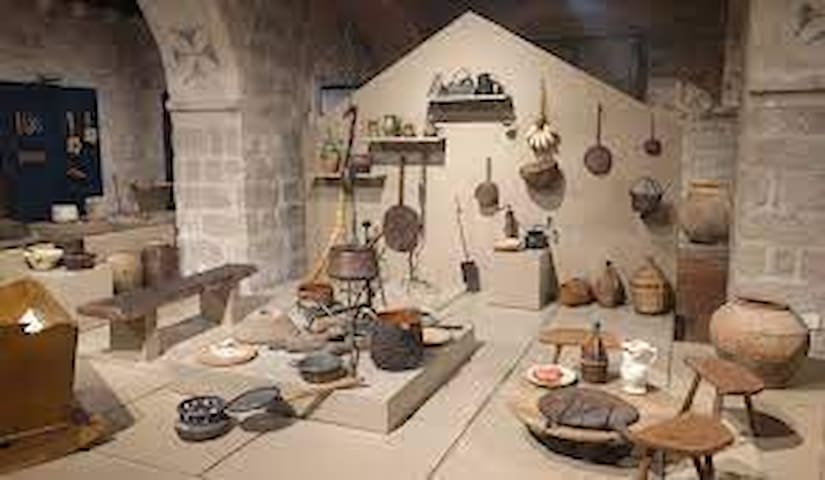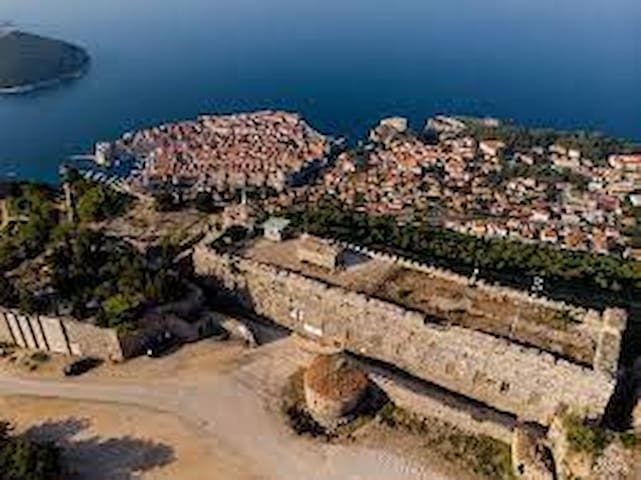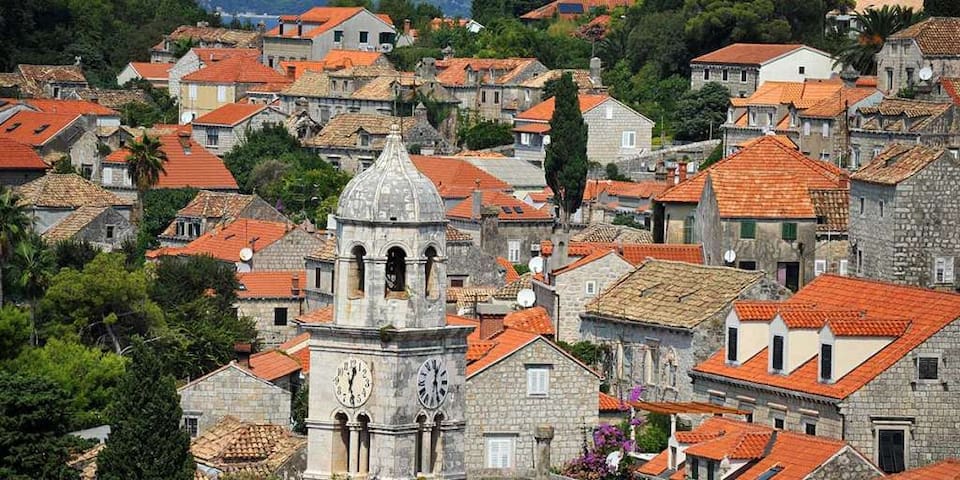Museums & Sightseeing
The residents of old Dubrovnik entered the city through two main gates, the eastern gate at Ploče and the western one at Pile. The draw bridges were pulled up at night to prevent passage to uninvited visitors. Entering the Pile gate, where one can see costumed city guards in summer, you come to the principal street called Placa or Stradun.
The main open-air public space of Dubrovnik, the favourite promenade and meeting place, the venue of all great festivities and processions, Stradun is the main shopping area and the widest and most beautiful street which divides the Old City into its northern and southern part. Its origins go back to the 11th century, when the people filled up the shallow sea channel which separated the one time Islet of Lave and a settlement on it from the land where another settlement existed.
Placa acquired its proper function in the late 12th century when both settlements were joined into one urban unit by a city wall complex. The name Placa comes from the Latin term "platea communis", denoting the venue of all major public events. The second name Stradun has a Venetian origin and means a large street.
The Large Onofrio Fountain stands at the eastern end of Stradun. It was named after the constructor of the 11,7- kilometre long Dubrovnik water supply system from the 15th century, which supplied the stone city with water from the village of Šumet located in the Dubrovnik hinterland.
A second, small fountain which Onofrio della Cava constructed was put up close to the city bell-tower. Today it still feels good to refresh oneself with cool water from the Dubrovnik fountains, while the bell-tower strikes the hours during the hot summer days.
The 31-metre high City Bell-Tower with a clock was built in 1444. In 1509 the famous foundryman Ivan Rabljanin cast the bell and the green men Baro and Maro. The Dubrovnik green men on the bell-tower strike on the hour, repeating the striking after three minutes, and also strike on the half-hour. Between the City Bell-Tower and Sponza Palace is Luža, the old bell-tower, which sounded the convoking of the Dubrovnik Republic council, but also fire and other alarms.
Luža was built in 1463, and thoroughly reconstructed in 1952. The monumental Sponza Palace stands on the left. Built in the Gothic-Renaissance style, it preserved its original form till the present day. At the time of the Dubrovnik Republic it housed the customs office and storehouses, and was therefore also called Divona (from the word dogana - meaning customs). Apart from the customs office, the state mint, the exchequer and treasury were also situated at the palace, designed by the Dubrovnik master Paskoje Miličević. Today the palace is the home of the major cultural institution of the Dubrovnik Archives. The documents which span the period from the 12th century to the fall of the Dubrovnik Republic which are kept there make this institution one of the most significant archives in the world. Particularly valuable is the collection of statutory and law books, including the Dubrovnik Statute from 1272.
The Dubrovnik Orlando Column is adorned with a statue of the medieval knight holding a sword in his hand. With a characteristic gothic smile on his face encircled with long curls, he is considered one of Europes handsomest Rolands. According to the contract from 1418 it was made by Bonino of Milan, with the help of the Dubrovnik masters. The Orlando Column is the symbol of statehood. On its pole, where the flag of the Dubrovnik Republic once flew, the Croatian national flag now stands. During the Festival of St Blaise, the Dubrovnik patron saint, the column is bedecked with a flag with his image, and during the Dubrovnik Summer Festival with the Libertas flag."
721 Recomendado por los habitantes de la zona
Stradun
The residents of old Dubrovnik entered the city through two main gates, the eastern gate at Ploče and the western one at Pile. The draw bridges were pulled up at night to prevent passage to uninvited visitors. Entering the Pile gate, where one can see costumed city guards in summer, you come to the principal street called Placa or Stradun.
The main open-air public space of Dubrovnik, the favourite promenade and meeting place, the venue of all great festivities and processions, Stradun is the main shopping area and the widest and most beautiful street which divides the Old City into its northern and southern part. Its origins go back to the 11th century, when the people filled up the shallow sea channel which separated the one time Islet of Lave and a settlement on it from the land where another settlement existed.
Placa acquired its proper function in the late 12th century when both settlements were joined into one urban unit by a city wall complex. The name Placa comes from the Latin term "platea communis", denoting the venue of all major public events. The second name Stradun has a Venetian origin and means a large street.
The Large Onofrio Fountain stands at the eastern end of Stradun. It was named after the constructor of the 11,7- kilometre long Dubrovnik water supply system from the 15th century, which supplied the stone city with water from the village of Šumet located in the Dubrovnik hinterland.
A second, small fountain which Onofrio della Cava constructed was put up close to the city bell-tower. Today it still feels good to refresh oneself with cool water from the Dubrovnik fountains, while the bell-tower strikes the hours during the hot summer days.
The 31-metre high City Bell-Tower with a clock was built in 1444. In 1509 the famous foundryman Ivan Rabljanin cast the bell and the green men Baro and Maro. The Dubrovnik green men on the bell-tower strike on the hour, repeating the striking after three minutes, and also strike on the half-hour. Between the City Bell-Tower and Sponza Palace is Luža, the old bell-tower, which sounded the convoking of the Dubrovnik Republic council, but also fire and other alarms.
Luža was built in 1463, and thoroughly reconstructed in 1952. The monumental Sponza Palace stands on the left. Built in the Gothic-Renaissance style, it preserved its original form till the present day. At the time of the Dubrovnik Republic it housed the customs office and storehouses, and was therefore also called Divona (from the word dogana - meaning customs). Apart from the customs office, the state mint, the exchequer and treasury were also situated at the palace, designed by the Dubrovnik master Paskoje Miličević. Today the palace is the home of the major cultural institution of the Dubrovnik Archives. The documents which span the period from the 12th century to the fall of the Dubrovnik Republic which are kept there make this institution one of the most significant archives in the world. Particularly valuable is the collection of statutory and law books, including the Dubrovnik Statute from 1272.
The Dubrovnik Orlando Column is adorned with a statue of the medieval knight holding a sword in his hand. With a characteristic gothic smile on his face encircled with long curls, he is considered one of Europes handsomest Rolands. According to the contract from 1418 it was made by Bonino of Milan, with the help of the Dubrovnik masters. The Orlando Column is the symbol of statehood. On its pole, where the flag of the Dubrovnik Republic once flew, the Croatian national flag now stands. During the Festival of St Blaise, the Dubrovnik patron saint, the column is bedecked with a flag with his image, and during the Dubrovnik Summer Festival with the Libertas flag."
One of the most significant monuments of profane architecture on the Croatian coast, the Rectors Palace, was the administrative centre of the Dubrovnik Republic. Its style is basically Gothic, with the Renaissance and Baroque reconstructions.
In the 15th century the Palace was destroyed twice in gunpowder explosions. Restored by Onofrio della Cava in the late Gothic style after the first explosion in 1435, the Palace got its present-day size with the central atrium and front portico.
The capitals were carved in Renaissance style by Pietro di Martino of Milan, whose capital with Aesculapius has been preserved on the right half-column of the portico. The second gunpowder explosion in 1463 destroyed the western facade of the Palace, and the two famous architects Juraj Dalmatinac and Michelozzo of Florence were engaged in the reconstruction for a short period.
Although the design of Michelozzo was unfortunately rejected, his influence in the restoration of the facade and portico, mainly in Renaissance style, can not be denied. After the earthquake of 1667 the atrium was partially reconstructed with an impressive Baroque staircase. During his one-month mandate the Rector of Dubrovnik lived in the Palace, which also housed the Minor and Major Council hall, the Rectors residence, the courtroom, administration office, prisons, an arsenal and gunpowder store-house. From the Rectors Palace one could enter the Great Council Palace.
The inscription: OBLITI PRIVATORUM PUBLICA CURATE (Forgetting your private business, concern yourselves with public affairs) can still be seen above the well preserved entrance door. A bust of the rich sea captain and benefactor Miho Pracat, the work by P. Giacometti from 1628, stands in the atrium.
It is the only public monument that the Dubrovnik Republic put up for a meritorious citizen. Today the Rectors Palace houses the Cultural-historic Department of the Dubrovnik Museum with exhibition halls arranged to display the original setting with antique furniture and objects for daily use, as well as paintings by local and Italian masters.
The Museum also guards a collection of old coins used in the Dubrovnik Republic, a collection of arms and utensils of Domus Christi Pharmacy from the 15th century. Apart from being exceptionally beautiful, the Rectors Palace Atrium has excellent acoustics, and is often used as a concert venue."
610 Recomendado por los habitantes de la zona
Palacio del Rector
3 Ul. Pred DvoromOne of the most significant monuments of profane architecture on the Croatian coast, the Rectors Palace, was the administrative centre of the Dubrovnik Republic. Its style is basically Gothic, with the Renaissance and Baroque reconstructions.
In the 15th century the Palace was destroyed twice in gunpowder explosions. Restored by Onofrio della Cava in the late Gothic style after the first explosion in 1435, the Palace got its present-day size with the central atrium and front portico.
The capitals were carved in Renaissance style by Pietro di Martino of Milan, whose capital with Aesculapius has been preserved on the right half-column of the portico. The second gunpowder explosion in 1463 destroyed the western facade of the Palace, and the two famous architects Juraj Dalmatinac and Michelozzo of Florence were engaged in the reconstruction for a short period.
Although the design of Michelozzo was unfortunately rejected, his influence in the restoration of the facade and portico, mainly in Renaissance style, can not be denied. After the earthquake of 1667 the atrium was partially reconstructed with an impressive Baroque staircase. During his one-month mandate the Rector of Dubrovnik lived in the Palace, which also housed the Minor and Major Council hall, the Rectors residence, the courtroom, administration office, prisons, an arsenal and gunpowder store-house. From the Rectors Palace one could enter the Great Council Palace.
The inscription: OBLITI PRIVATORUM PUBLICA CURATE (Forgetting your private business, concern yourselves with public affairs) can still be seen above the well preserved entrance door. A bust of the rich sea captain and benefactor Miho Pracat, the work by P. Giacometti from 1628, stands in the atrium.
It is the only public monument that the Dubrovnik Republic put up for a meritorious citizen. Today the Rectors Palace houses the Cultural-historic Department of the Dubrovnik Museum with exhibition halls arranged to display the original setting with antique furniture and objects for daily use, as well as paintings by local and Italian masters.
The Museum also guards a collection of old coins used in the Dubrovnik Republic, a collection of arms and utensils of Domus Christi Pharmacy from the 15th century. Apart from being exceptionally beautiful, the Rectors Palace Atrium has excellent acoustics, and is often used as a concert venue."
Westwards from the Bell-Tower stands the exquisite Customs Palace Divona, called Sponza, built in Dubrovniks specific Gothic-Renaissance style. The Palace that also served as the mint and arsenal, was constructed in the 16th century according to the design of Paskoje Miličević. Built in a rectangular shape, it has a shady portico and atrium. The stone-mason’s works were mainly performed by the Andrijić Brothers. The doors in the atrium and the first floor portico lead to the storages.
The following inscription can be read on the main wall: FALLERE NOSTRAVETANT; ET FALL PONDERE: MEQVE PONDERO CVM MERCES PONDERAT IPSE DEUS (We are forbidden to cheat or falsify measures, and when I weigh goods, God himself is weighing them with me). This Palace was the liveliest commercial centre of the City, and in the 17th century it became the meeting place of members of the Academy of the Learned, who used to discuss literature, arts and science. Today the Sponza Palace houses the Dubrovnik Archives, considered to be among the richest in Europe."
238 Recomendado por los habitantes de la zona
Sponza Palace
2 StradunWestwards from the Bell-Tower stands the exquisite Customs Palace Divona, called Sponza, built in Dubrovniks specific Gothic-Renaissance style. The Palace that also served as the mint and arsenal, was constructed in the 16th century according to the design of Paskoje Miličević. Built in a rectangular shape, it has a shady portico and atrium. The stone-mason’s works were mainly performed by the Andrijić Brothers. The doors in the atrium and the first floor portico lead to the storages.
The following inscription can be read on the main wall: FALLERE NOSTRAVETANT; ET FALL PONDERE: MEQVE PONDERO CVM MERCES PONDERAT IPSE DEUS (We are forbidden to cheat or falsify measures, and when I weigh goods, God himself is weighing them with me). This Palace was the liveliest commercial centre of the City, and in the 17th century it became the meeting place of members of the Academy of the Learned, who used to discuss literature, arts and science. Today the Sponza Palace houses the Dubrovnik Archives, considered to be among the richest in Europe."
Dubrovnik has opened to the public yet more proof of the wisdom of its glorious past. In the heart of this walled City, an expected, yet astonishing discovery has been revealed and expertly presented: a uniquely preserved industrial zone, a medieval foundry under Fort Minčeta from the late 15th century.
The discovery proves that, apart from being a trade centre, Dubrovnik was a city in which production also took place. Everything began in 2003, when the Society of Friends of Dubrovnik Antiquities, which zealously takes care of the Dubrovnik fortification complex, decided to restore the Gornji Ugao Tower (the Upper Corner). Together with the original Minčeta Fort, this quadrangular fort flanked the fortification element called kliješta (pincers). In the 15th century, following the development of defence structures, both forts were directly connected with the city wall. The kliješta consequently disappeared as a defence element, and became an outstandingly important part of the City. Archaeological research and explorations within the Gornji Ugao Tower carried out during a three year period (2005 – 2008) resulted in the gradual discovery of a metallurgic foundry, which – much to the delight of the researchers, archaeologists who used archaeometry as „a forensic method“, historians, architects and conservationists – unearthed a true industrial miracle!
All traces of the production process of the entire economic and metallurgic zone, covering an area of some 600 square metres, have been found intact.
Remains of the foundry architecture have been discovered with all its original
segments: a forge, the mould-casting section, water basins, a sedimentation channel and a sand depository. This is where gunpowder was prepared, bronze was cast, bells were moulded and tools made. However, most important was the production of weapons – cannonballs and bullets in various sizes, which the Dubrovnik Republic exported to the Mediterranean and the Balkans. It was an almost ideal location for the vital economic drive of the City- State, under the eye and control of the authorities, protected by the city walls, and yet separated from the residential area, in order to protect the inhabitants from the smoke, smell, as well as from fire. The foundry under Fort Minčeta was functional until the 17th century, and a large number of ceramic objects was discovered in the earthen embankment under which the foundry was buried after the great earthquake in 1667. This major discovery has enabled a presentation of the foundry complex together with the interior of the Gornji Ugao Tower, which – owing to excellent restoration – now serves as a museum of movable archaeological finds. Dubrovnik has got another attraction within the magnificent city wall complex. Following the idea of the researcher and chief designer, Dr. Željko Peković, a reinforced-concrete slab - which now serves as a sports ground - was laid over the foundry site, while the impressively illuminated historic foundry can be seen from a transparent elevated passage leading to each of its incredibly interesting sections.
In its promotional campaign featuring this new, but somewhat isolated attraction, the Society of Friends of Dubrovnik Antiquities has announced a continuation of the project – a special tour which starts from the Arcimon
Tower, along the northern outer wall up to Fort Minčeta and the outstandingly presented foundry site, continues along the outer wall up to Fort Bokar - where a museum of Dubrovnik artillery will be established – and ends at the Na Andriji archaeological locality. A true cultural delicacy!"
47 Recomendado por los habitantes de la zona
The Foundry Museum (Gornji Ugao)
2 Ul. Ispod MinčeteDubrovnik has opened to the public yet more proof of the wisdom of its glorious past. In the heart of this walled City, an expected, yet astonishing discovery has been revealed and expertly presented: a uniquely preserved industrial zone, a medieval foundry under Fort Minčeta from the late 15th century.
The discovery proves that, apart from being a trade centre, Dubrovnik was a city in which production also took place. Everything began in 2003, when the Society of Friends of Dubrovnik Antiquities, which zealously takes care of the Dubrovnik fortification complex, decided to restore the Gornji Ugao Tower (the Upper Corner). Together with the original Minčeta Fort, this quadrangular fort flanked the fortification element called kliješta (pincers). In the 15th century, following the development of defence structures, both forts were directly connected with the city wall. The kliješta consequently disappeared as a defence element, and became an outstandingly important part of the City. Archaeological research and explorations within the Gornji Ugao Tower carried out during a three year period (2005 – 2008) resulted in the gradual discovery of a metallurgic foundry, which – much to the delight of the researchers, archaeologists who used archaeometry as „a forensic method“, historians, architects and conservationists – unearthed a true industrial miracle!
All traces of the production process of the entire economic and metallurgic zone, covering an area of some 600 square metres, have been found intact.
Remains of the foundry architecture have been discovered with all its original
segments: a forge, the mould-casting section, water basins, a sedimentation channel and a sand depository. This is where gunpowder was prepared, bronze was cast, bells were moulded and tools made. However, most important was the production of weapons – cannonballs and bullets in various sizes, which the Dubrovnik Republic exported to the Mediterranean and the Balkans. It was an almost ideal location for the vital economic drive of the City- State, under the eye and control of the authorities, protected by the city walls, and yet separated from the residential area, in order to protect the inhabitants from the smoke, smell, as well as from fire. The foundry under Fort Minčeta was functional until the 17th century, and a large number of ceramic objects was discovered in the earthen embankment under which the foundry was buried after the great earthquake in 1667. This major discovery has enabled a presentation of the foundry complex together with the interior of the Gornji Ugao Tower, which – owing to excellent restoration – now serves as a museum of movable archaeological finds. Dubrovnik has got another attraction within the magnificent city wall complex. Following the idea of the researcher and chief designer, Dr. Željko Peković, a reinforced-concrete slab - which now serves as a sports ground - was laid over the foundry site, while the impressively illuminated historic foundry can be seen from a transparent elevated passage leading to each of its incredibly interesting sections.
In its promotional campaign featuring this new, but somewhat isolated attraction, the Society of Friends of Dubrovnik Antiquities has announced a continuation of the project – a special tour which starts from the Arcimon
Tower, along the northern outer wall up to Fort Minčeta and the outstandingly presented foundry site, continues along the outer wall up to Fort Bokar - where a museum of Dubrovnik artillery will be established – and ends at the Na Andriji archaeological locality. A true cultural delicacy!"
Tip: taxi to the hill Srđ and this spot is much cheaper!
The best views of Dubrovnik and the surrounding area are experienced from the top of the Srd Hill. The Dubrovnik Cable Car was built back in 1969 and was enthusiastically used by millions of visitors who wanted to enjoy the most beautiful panoramic views. On a clear day, you can see up to 60 km (37 miles). For this reason the neighbouring Imperial Fortress was strategically built on this privileged spot, back in the early 19th century."
811 Recomendado por los habitantes de la zona
Catedral de Dubrovnik
1 Ul. kneza Damjana JudeTip: taxi to the hill Srđ and this spot is much cheaper!
The best views of Dubrovnik and the surrounding area are experienced from the top of the Srd Hill. The Dubrovnik Cable Car was built back in 1969 and was enthusiastically used by millions of visitors who wanted to enjoy the most beautiful panoramic views. On a clear day, you can see up to 60 km (37 miles). For this reason the neighbouring Imperial Fortress was strategically built on this privileged spot, back in the early 19th century."
The Dominican museum is located within the monasterys cloister.
It houses the most important works by the Dubrovnik Painters School dating to the 15th and 16th centuries, canvases by Božidarević, Hamzić and Dobričević, votive jewelry, relics, manuscripts, incunabulas, valuable documents, bulls from various popes, an icon of the Virgin Mary with child and Titians painting of St. Blaise, Maria Magdalena and the angel Rafael, which was recently restored. A large cross, the work of Paolo Veneziana from the 14th century, is found in St. Dominics Church.
Working hours in summer (1 May - 31 October):
9.00 am - 6.00 pm
Working hours in winter:
9.00 am - 5.00 pm
78 Recomendado por los habitantes de la zona
Dominican Monastery
4 Ul. Svetog DominikaThe Dominican museum is located within the monasterys cloister.
It houses the most important works by the Dubrovnik Painters School dating to the 15th and 16th centuries, canvases by Božidarević, Hamzić and Dobričević, votive jewelry, relics, manuscripts, incunabulas, valuable documents, bulls from various popes, an icon of the Virgin Mary with child and Titians painting of St. Blaise, Maria Magdalena and the angel Rafael, which was recently restored. A large cross, the work of Paolo Veneziana from the 14th century, is found in St. Dominics Church.
Working hours in summer (1 May - 31 October):
9.00 am - 6.00 pm
Working hours in winter:
9.00 am - 5.00 pm
One of the most beautiful sacral buildings in Dubrovnik, the present-day Church of St Blaise was constructed in 1715 in the flamboyant Venetian Baroque style. It was constructed by the Venetian master Marino Gropelli in 1706, on the commission of the Dubrovnik Senate which requested a new church on the site of the old 14th century Romanesque church.
Damaged during the earthquake for the first time, the church was destroyed completely by the devastating fire in 1706. Everything disappeared in flames, apart from the silver statue of St Blaise, which was saved by some miracle. After the years spent in exile at the Church of St Nicholas at Prijeko, the statue was returned to its old place in 1715. The people of Dubrovnik added the following inscription on the statue all other statues made of gold, silver and bronze melted in the fire, while the saints statue was miraculously undamaged. The statue is one of the most important statues in Dubrovnik, and the model of the city which the saint holds in his hand reveals the city architecture at the time.
St Blaise has been honoured as the patron saint of Dubrovnik from the 10th century. According to the chroniclers of Dubrovnik, St Blaise saved the people of Dubrovnik in the 10th century when the Venetians anchored their ships in Gruž and in front of the Island of Lokrum. The people of Dubrovnik believed the Venetians assurances that they would leave for Levant after they supplied themselves with food and drink. The visitors used the opportunity to see the sights and observed the weaknesses in the City defence. However, St Blaise revealed their intentions to the parish priest Stojko and thus saved the City from the night attack. The priest described him as an old grey-haired man with a long beard, a bishops cap and a stick in his hand. Precisely the way his statues on the city walls and towers look like.
Celebrated on 3 February, St Blaises Day is also the City of Dubrovnik Day.
193 Recomendado por los habitantes de la zona
Church of Saint Blaise
2 Luža ul.One of the most beautiful sacral buildings in Dubrovnik, the present-day Church of St Blaise was constructed in 1715 in the flamboyant Venetian Baroque style. It was constructed by the Venetian master Marino Gropelli in 1706, on the commission of the Dubrovnik Senate which requested a new church on the site of the old 14th century Romanesque church.
Damaged during the earthquake for the first time, the church was destroyed completely by the devastating fire in 1706. Everything disappeared in flames, apart from the silver statue of St Blaise, which was saved by some miracle. After the years spent in exile at the Church of St Nicholas at Prijeko, the statue was returned to its old place in 1715. The people of Dubrovnik added the following inscription on the statue all other statues made of gold, silver and bronze melted in the fire, while the saints statue was miraculously undamaged. The statue is one of the most important statues in Dubrovnik, and the model of the city which the saint holds in his hand reveals the city architecture at the time.
St Blaise has been honoured as the patron saint of Dubrovnik from the 10th century. According to the chroniclers of Dubrovnik, St Blaise saved the people of Dubrovnik in the 10th century when the Venetians anchored their ships in Gruž and in front of the Island of Lokrum. The people of Dubrovnik believed the Venetians assurances that they would leave for Levant after they supplied themselves with food and drink. The visitors used the opportunity to see the sights and observed the weaknesses in the City defence. However, St Blaise revealed their intentions to the parish priest Stojko and thus saved the City from the night attack. The priest described him as an old grey-haired man with a long beard, a bishops cap and a stick in his hand. Precisely the way his statues on the city walls and towers look like.
Celebrated on 3 February, St Blaises Day is also the City of Dubrovnik Day.
Dubrovniks baroque Assumption of the Virgin Mary Cathedral was built in the 18th century over the earlier Romanesque Cathedral dating to the 12th century, which was destroyed in the great earthquake of 1667.
The construction of the Romanesque Cathedral is tied to the legend of King Richard the Lion-Hearted. Legend has it that he was shipwrecked and saved on the island of Lokrum on his return journey from the Third Crusade. In gratitude, he donated a certain sum of money for the completion of Marys Cathedral. And today, the crypt located underneath the baroque cathedral can be visited on special request.
The Treasury inside the cathedral houses 132 relics of saints dating from the 11th to the 19th centuries. The priceless head, arms and leg relics of St. Blaise that were crafted by Dubrovnik goldsmiths date between the 11th and 12th centuries.
Working hours in summer (4 April - 1 November):
Work days 9.00 am - 5.00 pm
Sundays and holidays 11.00 am - 5.00 pm
Working hours in winter:
Work days 10.00 am - 12.00 am and 3.00 pm - 5.00 pm
Sundays and holidays 11.00 am - 12.00 am and 3.00 pm - 5.00 pm
Location: Old Town
811 Recomendado por los habitantes de la zona
Catedral de Dubrovnik
1 Ul. kneza Damjana JudeDubrovniks baroque Assumption of the Virgin Mary Cathedral was built in the 18th century over the earlier Romanesque Cathedral dating to the 12th century, which was destroyed in the great earthquake of 1667.
The construction of the Romanesque Cathedral is tied to the legend of King Richard the Lion-Hearted. Legend has it that he was shipwrecked and saved on the island of Lokrum on his return journey from the Third Crusade. In gratitude, he donated a certain sum of money for the completion of Marys Cathedral. And today, the crypt located underneath the baroque cathedral can be visited on special request.
The Treasury inside the cathedral houses 132 relics of saints dating from the 11th to the 19th centuries. The priceless head, arms and leg relics of St. Blaise that were crafted by Dubrovnik goldsmiths date between the 11th and 12th centuries.
Working hours in summer (4 April - 1 November):
Work days 9.00 am - 5.00 pm
Sundays and holidays 11.00 am - 5.00 pm
Working hours in winter:
Work days 10.00 am - 12.00 am and 3.00 pm - 5.00 pm
Sundays and holidays 11.00 am - 12.00 am and 3.00 pm - 5.00 pm
Location: Old Town
Jesuit Church - Dubrovniks most beautiful baroque complex!
The baroque stairs connecting Gundulić Square with another square named after the great Dubrovnik physicist Ruđer Bošković are reminiscent of some etymologists who believe that the word baroque originated from the word shell. The one time venue of Shakespeares play Romeo and Juliet, the beautiful stairs very much resemble the ones leading to the Trinit? dei Monti Church in Rome from the Piazza di Spagna. Designed by the Roman architect Pietro Passalacque in 1738, the stairs lead to St Ignatius Church adjacent to the famous Jesuit school Collegium Ragusinum. The Church of St Ignatius - or the Jesuits, as the people of Dubrovnik call it - is the work of the famed Jesuit architect and painter Ignazio Pozzo, who worked on the church from 1699 to 1703.
The church was completed in 1725 and opened in 1729. The construction of both the Church and the Collegium began with the funds donated by a Jesuit from the Gundulić family, yet the donor had died before the designs were completed. The Collegium Ragusinum was actually founded because the people of Dubrovnik were dissatisfied with the Italian teachers with whom they often came into conflict. As soon as he was appointed, the Italian born head of the Dubrovnik diocese Beccadelli initiated the opening of the Jesuit Collegium in 1555.
The idea was realised as late as in 1658, after numerous problems with the ownership of the land had been solved. Namely, in order to build the Collegium and the Church, a large number of houses in the oldest part of the city had to be demolished. This complex is considered to be the finest Baroque set of buildings in Dubrovnik, and - according to many - in all of Dalmatia. It is thus not surprising that theatre directors at the Dubrovnik Summer Festival often use this venue as an open-air stage.
9 Recomendado por los habitantes de la zona
Saint Ignatius
7 Poljana Ruđera BoškovićaJesuit Church - Dubrovniks most beautiful baroque complex!
The baroque stairs connecting Gundulić Square with another square named after the great Dubrovnik physicist Ruđer Bošković are reminiscent of some etymologists who believe that the word baroque originated from the word shell. The one time venue of Shakespeares play Romeo and Juliet, the beautiful stairs very much resemble the ones leading to the Trinit? dei Monti Church in Rome from the Piazza di Spagna. Designed by the Roman architect Pietro Passalacque in 1738, the stairs lead to St Ignatius Church adjacent to the famous Jesuit school Collegium Ragusinum. The Church of St Ignatius - or the Jesuits, as the people of Dubrovnik call it - is the work of the famed Jesuit architect and painter Ignazio Pozzo, who worked on the church from 1699 to 1703.
The church was completed in 1725 and opened in 1729. The construction of both the Church and the Collegium began with the funds donated by a Jesuit from the Gundulić family, yet the donor had died before the designs were completed. The Collegium Ragusinum was actually founded because the people of Dubrovnik were dissatisfied with the Italian teachers with whom they often came into conflict. As soon as he was appointed, the Italian born head of the Dubrovnik diocese Beccadelli initiated the opening of the Jesuit Collegium in 1555.
The idea was realised as late as in 1658, after numerous problems with the ownership of the land had been solved. Namely, in order to build the Collegium and the Church, a large number of houses in the oldest part of the city had to be demolished. This complex is considered to be the finest Baroque set of buildings in Dubrovnik, and - according to many - in all of Dalmatia. It is thus not surprising that theatre directors at the Dubrovnik Summer Festival often use this venue as an open-air stage.
The Museum is accessible from Celestina Medovića Street.
It houses a collection of paintings from the 16th to the 19th century, liturgical items, a 14th century procession cross, two 18th century looms, lacework and embroidery. Most of the exhibits were either votive gifts or manufactured at the convent.
Open upon request in advance
SAMOSTAN SIGURATE
13 Ulica od SigurateThe Museum is accessible from Celestina Medovića Street.
It houses a collection of paintings from the 16th to the 19th century, liturgical items, a 14th century procession cross, two 18th century looms, lacework and embroidery. Most of the exhibits were either votive gifts or manufactured at the convent.
Open upon request in advance
Lovrjenac Fort is situated to the west of the Old City on a 37 metre-high rock.
The symbol of Dubrovniks survival and freedom, the fort was used for the defence of the city and the western Pile gate.
Above the entrance to the fort is the famed inscription: NON BENE PRO TOTO LIBERTAS VENDITUR AURO (Freedom is not sold for all gold in the world).
The first official records mention the fort in 1301, although it is believed that its construction began earlier. Today Lovrjenac is well-known as one of the Dubrovnik Summer Festival open-air venues particularly suitable for works by William Shakespeare. Among the finest actors who appeared here in the role of the unfortunate prince of Denmark are Daniel Day Lewis and Goran Višnjić.
176 Recomendado por los habitantes de la zona
Lovrijenac
29 Ul. od TabakarijeLovrjenac Fort is situated to the west of the Old City on a 37 metre-high rock.
The symbol of Dubrovniks survival and freedom, the fort was used for the defence of the city and the western Pile gate.
Above the entrance to the fort is the famed inscription: NON BENE PRO TOTO LIBERTAS VENDITUR AURO (Freedom is not sold for all gold in the world).
The first official records mention the fort in 1301, although it is believed that its construction began earlier. Today Lovrjenac is well-known as one of the Dubrovnik Summer Festival open-air venues particularly suitable for works by William Shakespeare. Among the finest actors who appeared here in the role of the unfortunate prince of Denmark are Daniel Day Lewis and Goran Višnjić.
Walking towards the eastern entrance to the City one faces the Lazaretto Complex at Ploče.
The Lazareti are the only fully preserved quarantine complex on the European side of the Mediterranean, and is under the protection of UNESCO since 1994.
In 1590, the Senate of the Dubrovnik Republic decided to situate it by the eastern City gate near the City Walls, at the intersection of main land and naval trade routes. The Lazareti were built from 1627 until 1647, and their significance for the protection of the City from dangerous invisible enemies: plague and other infectious diseases, was confirmed in 1724 when they were declared an integral part of the City’s fortifications. The complex resembles the City Walls, and consists of the plateau and ten naves (halls) with five inner courtyards.
Today, the Lazareti are the creative hub of Dubrovnik: various exhibitions, concerts, workshops, lectures, congresses and other events are organized in five western naves of the complex. Two naves are home to the Linđo Folk Music Ensamble and in the three eastern naves Art Workshop Lazareti, Deša and Lero Student Theatre organize their activities.
The most attractive Dubrovnik hotels Excelsior and Argentina, as well as the Museum of Modern Art Dubrovnik in the monumental villa from 1939, are also situated at Ploče.
42 Recomendado por los habitantes de la zona
Lazareti
Ulica Frana SupilaWalking towards the eastern entrance to the City one faces the Lazaretto Complex at Ploče.
The Lazareti are the only fully preserved quarantine complex on the European side of the Mediterranean, and is under the protection of UNESCO since 1994.
In 1590, the Senate of the Dubrovnik Republic decided to situate it by the eastern City gate near the City Walls, at the intersection of main land and naval trade routes. The Lazareti were built from 1627 until 1647, and their significance for the protection of the City from dangerous invisible enemies: plague and other infectious diseases, was confirmed in 1724 when they were declared an integral part of the City’s fortifications. The complex resembles the City Walls, and consists of the plateau and ten naves (halls) with five inner courtyards.
Today, the Lazareti are the creative hub of Dubrovnik: various exhibitions, concerts, workshops, lectures, congresses and other events are organized in five western naves of the complex. Two naves are home to the Linđo Folk Music Ensamble and in the three eastern naves Art Workshop Lazareti, Deša and Lero Student Theatre organize their activities.
The most attractive Dubrovnik hotels Excelsior and Argentina, as well as the Museum of Modern Art Dubrovnik in the monumental villa from 1939, are also situated at Ploče.
In 1872, the Patriotic Museum was founded in Dubrovnik; in the middle of 1873, the first museum display was made in the commune building. Among the exhibits, which were mainly from the period of the Dubrovnik Republic, the archaeological objects nevertheless stood out, for example, an Egyptian mummy, Greek vases and ancient amphorae.
The donors were collectors, leading members of patrician families, sailors and Dubrovnik people living elsewhere. Foremost among them were the great benefactors and donors the Amerling brothers, who had been passionate advocates of the museum’s founding; they gave most of the Egyptian, oriental and Japanese objects, birds, minerals and rarities of all kinds. In 1882, Arthur Evans, world renowned archaeologist and initiator of archaeological research in the Dubrovnik area, gifted to the museum three Roman funerary inscriptions from Cavtat, the first entries into the book of donated and purchased objects.
At the time the science of archaeology was being founded in Croatia in the early 20th century, lovers of antiquities gathered around the Dubrovnik branch of the Croatian Antiquarian Society in Knin and the Braće Hrvatskog Zmaja started to investigate the ruined Church of St Stephen, and after that it served as a temporary lapidarium for pre-Romanesque sculpture.
In 1932 the Patriotic Museum obtained the use of the first floor of Fort St John, and then for the first time the collections were formed, including the archaeological. In 1941 the exhibits were stored in the ground floor of The Holes granary; the finest examples of stone sculpture were exhibited in the same space, where they remained until the building was converted into the Ethnographic Museum.
Some of the stone monuments were moved in 1960, at the suggestion of the Association of the Friends of Dubrovnik Antiquities, from The Holes to Bokar Fort; three years later, the department started its first archaeological research.
In the 1990s it turned into the Archaeological Museum, part of Dubrovnik Museums. The holdings have increased in size many times as a result of ongoing archaeological investigations, and have been divided into eight collections, covering a period of time from the early Neolithic to the second half of the 17th century, that is to the great earthquake of 1667.
As the space for a permanent display has not yet been settled on, the museum presents the rich archaeological history of the Dubrovnik area in occasional or ad hoc exhibitions. In the ground floor of Revelin Fortress, of which it has been given the temporary use, there are currently two exhibitions on show: Early Medieval Sculpture of Dubrovnik and Environs and Revelin – Archaeological Research / Spatial Development / Foundry.
16 Recomendado por los habitantes de la zona
Archeological Museum
Ulica Svetog DominikaIn 1872, the Patriotic Museum was founded in Dubrovnik; in the middle of 1873, the first museum display was made in the commune building. Among the exhibits, which were mainly from the period of the Dubrovnik Republic, the archaeological objects nevertheless stood out, for example, an Egyptian mummy, Greek vases and ancient amphorae.
The donors were collectors, leading members of patrician families, sailors and Dubrovnik people living elsewhere. Foremost among them were the great benefactors and donors the Amerling brothers, who had been passionate advocates of the museum’s founding; they gave most of the Egyptian, oriental and Japanese objects, birds, minerals and rarities of all kinds. In 1882, Arthur Evans, world renowned archaeologist and initiator of archaeological research in the Dubrovnik area, gifted to the museum three Roman funerary inscriptions from Cavtat, the first entries into the book of donated and purchased objects.
At the time the science of archaeology was being founded in Croatia in the early 20th century, lovers of antiquities gathered around the Dubrovnik branch of the Croatian Antiquarian Society in Knin and the Braće Hrvatskog Zmaja started to investigate the ruined Church of St Stephen, and after that it served as a temporary lapidarium for pre-Romanesque sculpture.
In 1932 the Patriotic Museum obtained the use of the first floor of Fort St John, and then for the first time the collections were formed, including the archaeological. In 1941 the exhibits were stored in the ground floor of The Holes granary; the finest examples of stone sculpture were exhibited in the same space, where they remained until the building was converted into the Ethnographic Museum.
Some of the stone monuments were moved in 1960, at the suggestion of the Association of the Friends of Dubrovnik Antiquities, from The Holes to Bokar Fort; three years later, the department started its first archaeological research.
In the 1990s it turned into the Archaeological Museum, part of Dubrovnik Museums. The holdings have increased in size many times as a result of ongoing archaeological investigations, and have been divided into eight collections, covering a period of time from the early Neolithic to the second half of the 17th century, that is to the great earthquake of 1667.
As the space for a permanent display has not yet been settled on, the museum presents the rich archaeological history of the Dubrovnik area in occasional or ad hoc exhibitions. In the ground floor of Revelin Fortress, of which it has been given the temporary use, there are currently two exhibitions on show: Early Medieval Sculpture of Dubrovnik and Environs and Revelin – Archaeological Research / Spatial Development / Foundry.
The Maritime Museum is located on the First and Second Floors of Fort St. Johns.
The Maritime Museum was founded in 1949 at the initiative of the Yugoslav (today the Croatian) Academy of Sciences and Arts; since 1987 it was been a part of the Dubrovnik Museums. The main part of the holdings arose from numerous donations of Dubrovnik citizens to the Patriotic Museum in the first half of the 20th century and objects from the exhibition Dubrovnik Seafaring through the Ages, which was put on in 1941.
Since 1952, the museum has been located on the first and second floors of Fort St John (sv. Ivan). In the past the fort guarded the entrance into the city port, and was one of the most important points of the city's defences. The construction works started in 1346, today's appearance being completed at the end of the 16th century. In the 19th century it was rebuilt into two floors, and at the places where there had been artillery embrasures, windows were installed.
The museum systematically collects, studies, exhibits and publishes the museum material from the maritime past of the Dubrovnik region, all the way since Antiquity. Today it has holdings of over five thousand objects classified into fifteen collections.
143 Recomendado por los habitantes de la zona
Maritime Museum
12 Ul. kneza Damjana JudeThe Maritime Museum is located on the First and Second Floors of Fort St. Johns.
The Maritime Museum was founded in 1949 at the initiative of the Yugoslav (today the Croatian) Academy of Sciences and Arts; since 1987 it was been a part of the Dubrovnik Museums. The main part of the holdings arose from numerous donations of Dubrovnik citizens to the Patriotic Museum in the first half of the 20th century and objects from the exhibition Dubrovnik Seafaring through the Ages, which was put on in 1941.
Since 1952, the museum has been located on the first and second floors of Fort St John (sv. Ivan). In the past the fort guarded the entrance into the city port, and was one of the most important points of the city's defences. The construction works started in 1346, today's appearance being completed at the end of the 16th century. In the 19th century it was rebuilt into two floors, and at the places where there had been artillery embrasures, windows were installed.
The museum systematically collects, studies, exhibits and publishes the museum material from the maritime past of the Dubrovnik region, all the way since Antiquity. Today it has holdings of over five thousand objects classified into fifteen collections.
The Ethnographic Museum is located in an old granary dating to the 16th century-
The Ethnographic Museum has its origins in the collection of traditional culture that began to be formed in the first decades of the twentieth century. Its holdings were very much enlarged with specimens of traditional attire and lace donated several times by that great benefactor of the museum, Jelka Miš (1875 -1956).
In the course of time, the collection grew into the ethnological department of Dubrovnik Museum, and in 1950 opened its first display of original ethnographic folk handicrafts from the local area on the second floor of Fort St John.
From February 2nd, 1991 the permanent display is housed in the building of the Dubrovnik Republic’s granary, popularly known as Rupe/The Holes, which derives from the name for the underground grain storage areas carved out of bedrock or tufa.
It was built in 1590, a four-storey structure with fifteen storage pits in the ground floor and spaces for drying on the upper floors. In the earthquake disaster of 1667, the building was seriously damaged, and the subsequent reconstruction turned it into the three-storey building that it is to this day.
The holdings of the Ethnographic Museum of Dubrovnik Museums have today some six thousand five hundred objects of the ethnographic heritage of the Dubrovnik region, the Croatian people and the nations of the surrounding states. Particularly prominent are collections of traditional attire from Dubrovačko primorje, the Elaphite islands, Konavle, Mljet, Lastovo, Pelješac, Korčula, Rijeka Dubrovačka and Župa Dubrovačka.
The permanent display in the ground floor of the building shows in situ the way grain was stored, while on the first and second floors the traditional economic activities and the rural architecture of the Dubrovnik surrounds are presented, together with holiday and festive dress, particular attention being drawn by one-of-a-kind items from the 19th century, with all the diversity of textile handicrafts in the Dubrovnik region.
161 Recomendado por los habitantes de la zona
Etnografic Museum Rupe
3 Ul. od RupaThe Ethnographic Museum is located in an old granary dating to the 16th century-
The Ethnographic Museum has its origins in the collection of traditional culture that began to be formed in the first decades of the twentieth century. Its holdings were very much enlarged with specimens of traditional attire and lace donated several times by that great benefactor of the museum, Jelka Miš (1875 -1956).
In the course of time, the collection grew into the ethnological department of Dubrovnik Museum, and in 1950 opened its first display of original ethnographic folk handicrafts from the local area on the second floor of Fort St John.
From February 2nd, 1991 the permanent display is housed in the building of the Dubrovnik Republic’s granary, popularly known as Rupe/The Holes, which derives from the name for the underground grain storage areas carved out of bedrock or tufa.
It was built in 1590, a four-storey structure with fifteen storage pits in the ground floor and spaces for drying on the upper floors. In the earthquake disaster of 1667, the building was seriously damaged, and the subsequent reconstruction turned it into the three-storey building that it is to this day.
The holdings of the Ethnographic Museum of Dubrovnik Museums have today some six thousand five hundred objects of the ethnographic heritage of the Dubrovnik region, the Croatian people and the nations of the surrounding states. Particularly prominent are collections of traditional attire from Dubrovačko primorje, the Elaphite islands, Konavle, Mljet, Lastovo, Pelješac, Korčula, Rijeka Dubrovačka and Župa Dubrovačka.
The permanent display in the ground floor of the building shows in situ the way grain was stored, while on the first and second floors the traditional economic activities and the rural architecture of the Dubrovnik surrounds are presented, together with holiday and festive dress, particular attention being drawn by one-of-a-kind items from the 19th century, with all the diversity of textile handicrafts in the Dubrovnik region.
The Croatian War of Independence Museum - Dubrovnik is located in one wing of Fort Imperial on Mount Srđ, which is the symbol of the defence of Dubrovnik.
The first phase of the permanent museum project Dubrovnik in the Croatian War of Independence 1991 - 1995 has been completed.
An exhibition of the same name has been put on at Fort Imperial with around 500 exhibits. The main themes include Dubrovnik in the Croatian War of Independence 1991 - 1995 and the history of Fort Imperial.
The Croatian War of Independence in the Dubrovnik area was presented within the following themed units:
The fall of the Dubrovnik Republic and history of Fort Imperial ;
The Serbian-Montenegrin aggression in 1991. ;
The days of victory - the liberation actions of the Croatian Army and the suffering of the people, civilian buildings and cultural monuments.
The exhibits include: documents, art and documentary photographs, printed materials, weapons, mines and explosive devices, war maps, commands, parts of military equipment, objects from every-day life which belonged to the residents and defenders of Dubrovnik under the aggressors siege, authentic recordings and video material, reminiscences of the participants, the armed forces war flags, the original flag which waved on Srđ in 1991, mine fields maps, war log books, etc.
A memorial plaque with the names of those who died defending Dubrovnik has been put up on Mount Srđ.
25 Recomendado por los habitantes de la zona
Homeland War Museum
2 Srđ ul.The Croatian War of Independence Museum - Dubrovnik is located in one wing of Fort Imperial on Mount Srđ, which is the symbol of the defence of Dubrovnik.
The first phase of the permanent museum project Dubrovnik in the Croatian War of Independence 1991 - 1995 has been completed.
An exhibition of the same name has been put on at Fort Imperial with around 500 exhibits. The main themes include Dubrovnik in the Croatian War of Independence 1991 - 1995 and the history of Fort Imperial.
The Croatian War of Independence in the Dubrovnik area was presented within the following themed units:
The fall of the Dubrovnik Republic and history of Fort Imperial ;
The Serbian-Montenegrin aggression in 1991. ;
The days of victory - the liberation actions of the Croatian Army and the suffering of the people, civilian buildings and cultural monuments.
The exhibits include: documents, art and documentary photographs, printed materials, weapons, mines and explosive devices, war maps, commands, parts of military equipment, objects from every-day life which belonged to the residents and defenders of Dubrovnik under the aggressors siege, authentic recordings and video material, reminiscences of the participants, the armed forces war flags, the original flag which waved on Srđ in 1991, mine fields maps, war log books, etc.
A memorial plaque with the names of those who died defending Dubrovnik has been put up on Mount Srđ.
A decree made by the government of the Dubrovnik Republic in 1546 allowed Jews to settle within the city ramparts.
This officially marks the establishment of the Jewish Ghetto on the street called Žudioska ulica. In 1652, one of the houses was turned into a Synagogue, whose interior is in the baroque style. It has been preserved to this day, with minor changes, and is one of the oldest synagogues in Europe. The first floor houses a museum with a number of religious artifacts and archive documents. The Torahs in particular, which date from the 13th to the 17th centuries, bear witness to Dubrovniks Jewish community throughout six centuries of history.
Besides the Synagogue, the Dubrovnik Jewish Community has its own cemetery at Boninovo and a small Jewish fountain at Pile.
Working hours: 1 May - 1 November: Every day 10.00 am - 8.00 pm
1 November - 1 May: 10.00 am - 3.00 pm,
Closed on Saturdays and Sundays"
196 Recomendado por los habitantes de la zona
Dubrovnik Synagogue
5 Žudioska ul.A decree made by the government of the Dubrovnik Republic in 1546 allowed Jews to settle within the city ramparts.
This officially marks the establishment of the Jewish Ghetto on the street called Žudioska ulica. In 1652, one of the houses was turned into a Synagogue, whose interior is in the baroque style. It has been preserved to this day, with minor changes, and is one of the oldest synagogues in Europe. The first floor houses a museum with a number of religious artifacts and archive documents. The Torahs in particular, which date from the 13th to the 17th centuries, bear witness to Dubrovniks Jewish community throughout six centuries of history.
Besides the Synagogue, the Dubrovnik Jewish Community has its own cemetery at Boninovo and a small Jewish fountain at Pile.
Working hours: 1 May - 1 November: Every day 10.00 am - 8.00 pm
1 November - 1 May: 10.00 am - 3.00 pm,
Closed on Saturdays and Sundays"
Cavtat, the antique Epidaurus, was an important Roman colony in this region, which expires after the breakthrough of the Slavs and the Avarians into this area after the decline of the Western Roman Empire, and their inhabitants flee to the neighbouring settlement Laus-Rave-Ragus, wherefrom Dubrovnik arose. In historical sources, Cavtat is also mentioned with the name Ragusa Vecchia, what clearly testifies to the connection of these two cities. In the times of the Dubrovnik Republic, Cavtat was the second most important seaport, place of trade and of administration in the Republic after Dubrovnik.
Places like Cavtat offering so much to the visitors are quite rare. Its scenery, the rich cultural and historical heritage along with the range of services offered to tourists meet the demands of the present day tourists, thus making it one of the most attractive destinations on the Adriatic coast. Cavtat is located between the magic city of Dubrovnik on one side and beautiful Konavle on the other. There one can still feel the spirit of the past time and experience the centuries old tradition of our ancestors. It is an ideal holiday resort. Each visitor can discover his own wishes, enjoy the hidden coves at peace, long walks at the seaside or spend active holidays going in for recreational sports and entertaining cultural programmes."
358 Recomendado por los habitantes de la zona
Cavtat
Cavtat, the antique Epidaurus, was an important Roman colony in this region, which expires after the breakthrough of the Slavs and the Avarians into this area after the decline of the Western Roman Empire, and their inhabitants flee to the neighbouring settlement Laus-Rave-Ragus, wherefrom Dubrovnik arose. In historical sources, Cavtat is also mentioned with the name Ragusa Vecchia, what clearly testifies to the connection of these two cities. In the times of the Dubrovnik Republic, Cavtat was the second most important seaport, place of trade and of administration in the Republic after Dubrovnik.
Places like Cavtat offering so much to the visitors are quite rare. Its scenery, the rich cultural and historical heritage along with the range of services offered to tourists meet the demands of the present day tourists, thus making it one of the most attractive destinations on the Adriatic coast. Cavtat is located between the magic city of Dubrovnik on one side and beautiful Konavle on the other. There one can still feel the spirit of the past time and experience the centuries old tradition of our ancestors. It is an ideal holiday resort. Each visitor can discover his own wishes, enjoy the hidden coves at peace, long walks at the seaside or spend active holidays going in for recreational sports and entertaining cultural programmes."

